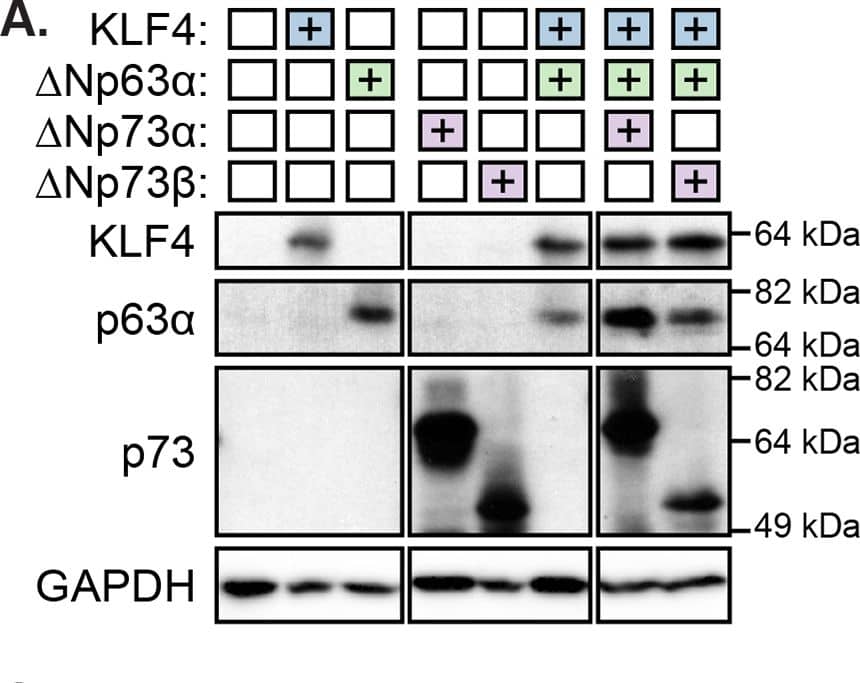Human p63/TP73L Antibody
R&D Systems, part of Bio-Techne | Catalog # AF1916


Key Product Details
Species Reactivity
Validated:
Cited:
Applications
Validated:
Cited:
Label
Antibody Source
Product Specifications
Immunogen
Met40-Cys339
Accession # Q9H3D4
Specificity
Clonality
Host
Isotype
Scientific Data Images for Human p63/TP73L Antibody
p63/TP73L in Human Breast.
p63/TP73L was detected in immersion fixed paraffin-embedded sections of human breast using Goat Anti-Human p63/TP73L Antigen Affinity-purified Polyclonal Antibody (Catalog # AF1916) at 15 µg/mL overnight at 4 °C. Tissue was stained using the Anti-Goat HRP-DAB Cell & Tissue Staining Kit (brown; Catalog # CTS008) and counterstained with hematoxylin (blue). Specific staining was localized to nuclei. View our protocol for Chromogenic IHC Staining of Paraffin-embedded Tissue Sections.p63/TP73L in SCC-25 Human Cell Line.
p63/TP73L was detected in immersion fixed SCC-25 human tongue carcinoma cell line using Goat Anti-Human p63/TP73L Antigen Affinity-purified Polyclonal Antibody (Catalog # AF1916) at 10 µg/mL for 3 hours at room temperature. Cells were stained using the NorthernLights™ 557-conjugated Anti-Goat IgG Secondary Antibody (yellow; Catalog # NL001) and counterstained with DAPI (blue). Specific staining was localized to nuclei. View our protocol for Fluorescent ICC Staining of Cells on Coverslips.Detection of Mouse p63/TP73L by Immunocytochemistry/Immunofluorescence
Analysis of p73 and p63 co-expression in human and murine skin.(A) Scatter plot of TP63 versus TP73 RNA-seq expression [units = transcripts per million (TPM)] by human tissue type (n = 37) from the Human Protein Atlas (172 total samples) [30]. Mean expression (TPM + 0.1) for each tissue is plotted on a log2 scale with a LOESS smooth local regression line (gray). Correlation between TP63 and TP73 was quantified using Spearman’s rank correlation coefficient (rs). (B) Representative micrographs of H&E and immunofluorescence (IF) staining on serial human (top) and mouse (bottom) skin sections; DAPI (blue), p63 alpha (green), and p73 (red). Regions of the skin in micrographs are labeled as: interfollicular epidermis (IFE), hair follicle (HF), outer root sheath (ORS), HF bulge (Bu), hair bulb (HB), sebaceous gland (SG), hair shaft (HS), and arrector pili muscle (APM). Scale bars represent 200 μm for human and 50 μm for murine tissue. See also S1 and S2 Figs. Image collected and cropped by CiteAb from the following publication (https://pubmed.ncbi.nlm.nih.gov/31216312), licensed under a CC-BY license. Not internally tested by R&D Systems.Applications for Human p63/TP73L Antibody
Immunocytochemistry
Sample: Immersion fixed FaDu human hypopharyngeal carcinoma cell line and SCC-25 human tongue carcinoma cell line
Immunohistochemistry
Sample: Immersion fixed paraffin-embedded sections of human breast
Western Blot
Sample: Recombinant Human p63/TP73L
Reviewed Applications
Read 4 reviews rated 4.3 using AF1916 in the following applications:
Formulation, Preparation, and Storage
Purification
Reconstitution
Formulation
Shipping
Stability & Storage
- 12 months from date of receipt, -20 to -70 °C as supplied.
- 1 month, 2 to 8 °C under sterile conditions after reconstitution.
- 6 months, -20 to -70 °C under sterile conditions after reconstitution.
Background: p63/TP73L
Tumor Protein 63 (p63), also named TP73L, TP63, p51, p40 or KET, is a p53 homolog. It is one of several proteins that are produced from a single gene using two promoters and alternative splicing of the primary RNA transcript. p63 is highly expressed in embryonic ectoderm and in the nuclei of basal regenerative cells of many epithelial tissues in the adult. p63 is suggested to play a role in development, epithelial cell maintenance and tumorigenesis (1‑3).
References
- Harms, K. et al. (2004), Cell Mol. Life Sci. 61(7):822.
- Koster, M.I. and D.R. Roop, J. Dermatol. Sci. 34(1):3.
- Benard, J. et al. (2003) Hum. Mutat. 21(3):182.
Long Name
Alternate Names
Entrez Gene IDs
Gene Symbol
UniProt
Additional p63/TP73L Products
Product Documents for Human p63/TP73L Antibody
Product Specific Notices for Human p63/TP73L Antibody
For research use only


